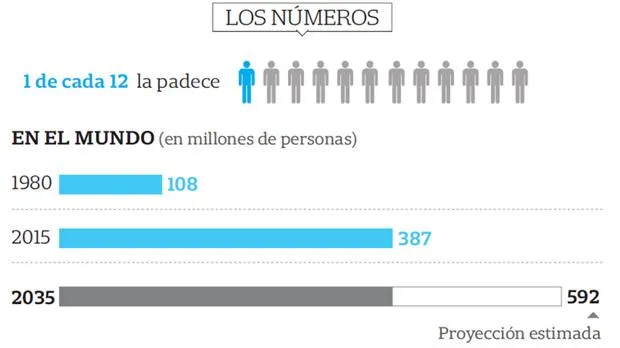Diabetes Atlas is getting bigger, and WHO dedicated this World Health Day to this disease this year.Throughout the globe, 387 million people live today with this condition, and it is expected that by 2035 the figure will increase to 592 million (more than 50%), of which half will never be diagnosed.
In Argentina, 1 in 10 adults suffer from the disease.In 95% of cases it is type 2, mainly associated with life styles that predominate in large cities: inadequate food, excess weight and sedentary lifestyle.
Since 2005, more than 40 new therapies have been approved for the treatment of type 2 diabetes, some with very impressive results.However, the goals achieved in the real world are well below the effective, for its acronym in English).
Current statistics reveal that only 3 out of 10 patients treated and adhesion to different therapies manage to control the adequate levels of blood glucose, that is, below 7%."But if we take into account that almost 50% of patients worldwide were not diagnosed, the situation is much more complicated -says Danish doctor Mads Krogsgaard Thomsen, Executive Director of Research and Development of Pharmaceutics Novo Nordisk-.Without diagnosis there is no treatment and without treatment the progressive complications of the disease begin, such as vascular, renal, eye and feet problems. "
Today, as 10 years ago, between the initial diagnosis and the beginning of an insulin replacement therapy, on average, between six and eight years.And taking into account that insulin constitutes the treatment of choice for patients who faillong -term complications.
A study carried out almost two decades ago in 13 European countries revealed that 58% of patients with type 2 diabetes were afraid to start injecting insulin."And they continue with that same fear, and doctors continue with that same inertia, and even often refer to the possibility of starting to use this hormone in a threat tone:« If it does not follow the diet and does not meet the indications,I will have to indicate insulin ».The necessary adjustments are made in the doses, the complications are already very advanced -says the endocrinologist Rosario Arachavaleta Granel, professor at the Autonomous University of Guadalajara, in Mexico.to get blind. "
Among other associated risks, uncontrolled diabetes increases two to four times the risk of cardiovascular disease and doubles the chances of having a cardiovascular accident (stroke).As the Danish doctor Krogsgaard Thomsen warns, it is shown that for each glycosylated hemoglobin point (A1C) above 7%, cardiovascular complications increase by 25%.And in this sense, it refers to the new Leader study presented in this congress and published in The New England Journal of Medicine, where the benefits of treatment with the Liraglutide drugs were demonstrated, which managed to reduce cardiovascular events and death in adults with diabetesType 2.
"The risks were reduced by 13%Cardiovascular, such as myocardial infarction and cerebrovascular attacks, better known as Stroke, among other non -fatal episodes.Another secondary outcome was seen in the least number of patients who died for a cardiovascular cause.In the group treated with Liraglutide, fatal outcomes were reduced by 22%, "added Dr. Yan Cai, medical director of Novo Nordisk.
For experts, patients with more likely to succeed are those who are informed about how to control their glucose levels, those who manage to take care of their treatment and glymia automation.
Dr. Diego Wappner is a specialist in Internal Medicine and Master in Diabetes.In his office he treats many diabetic patients, and, from their daily experience with them, he believes: "I think that with diabetes there is a problem of other chronic diseases in which the active participation of the individual in his care has a fundamental role.And frustration.


